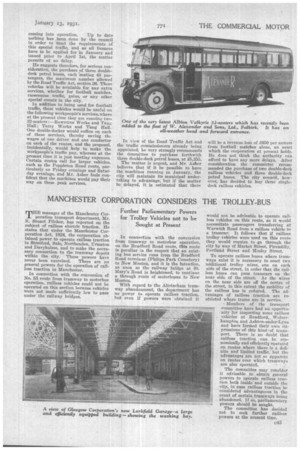MANCHESTER CORPORATION CONSIDERS THE TROLLEY-BUS
Page 67

If you've noticed an error in this article please click here to report it so we can fix it.
Further Parliamentary Powers for Trolley Vehicles not to be Sought at Present THE manager of the Manchester Corporation transport department, Mr. R. Stuart Pileher, has reported on the subject of tailless electric traction. He states that under the Manchester Corporation Act, 1924, the corporation obtained power to operate tailless traction in Stretford, Sale, Northenden, Urmston and Davyhulme, and to make the necessary connection to the tramway depots within the city. These powers have
never been exercised. There are /to general powers for the operation of tailless traction in Manchester.
In connection with the conversion of No. 53 route from tramway to motorbus operation, tailless vehicles could not be operated on this section because vehicles were not made sufficiently low to pass under the railway bridges. In connection with the conversion from tramway to motorbus operation, on the Bradford Road route, this route is peculiar in the respect that an existing bus service runs from the Bradford Road terminus (Philips Park Cemetery) to New Moston, and it is the intention, as soon as the railway bridge at St. Mary's Road is heightened, to continue a through route of motorbuses to New Moston.
With regard to the Altrincham tramway abandonment, the department has no power to operate tailless traction, but even if powers were obtained it would not be advisable to operate tailless vehicles on this route, as it would necessitate passengers transferring at Warwick Road from a tailless vehicle to a tramcar. It follows that if tailless trolley vehicles were used on this route they would require to go through the city by way of Market Street, Piccadilly, Portland Street and Mosley Street.
To operate tailless buses where tramways exist it is necessary to erect two additional trolley wires, one on each side of the street, in order that the tailless buses can pass tramcars on the near side of the street. As the wires on the near side are off the centre of the street, to this extent the mobility of the tailless bus is reduced. The advantages of tailless traction are restricted where trams are in service.
Members of the transport committee have had an opportunity for inspecting some tailless vehicles at Bradford, Wolverhampton and Ashton-under-Lyne and have formed their own impressions of this kind of transport. There is no doubt that tailless traction can be economically and efficiently operated on routes where there is a dennite and limited traffic, but the advantages are not so apparent on routes over which tramways are also operated. _
The committee may consider it advisable to obtain general • powers to operate tailless traction both inside-and outside the City, in case tailless traction be censidered advantageous in the event of certain tramways being abandoned. If so, parliamentary powers should be sought.
The committee has decided not to seek further tailless powers at the Present time.












































































































